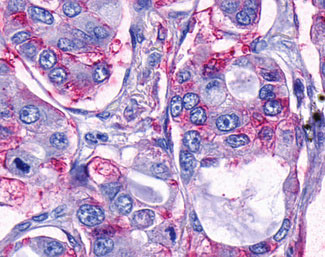TAAR9 Antibody (Extracellular Domain)
Rabbit Polyclonal Antibody
- SPECIFICATION
- CITATIONS
- PROTOCOLS
- BACKGROUND

Application
| IHC-P |
|---|---|
| Primary Accession | Q96RI9 |
| Reactivity | Human, Mouse, Hamster, Monkey, Pig |
| Host | Rabbit |
| Clonality | Polyclonal |
| Calculated MW | 39kDa |
| Dilution | IHC-P (34 µg/ml) |
| Gene ID | 134860 |
|---|---|
| Other Names | Trace amine-associated receptor 9, TaR-9, Trace amine receptor 9, Trace amine receptor 3, TaR-3, TAAR9, TA3, TAR3, TRAR3 |
| Target/Specificity | Human TAAR9. BLAST analysis of the peptide immunogen showed no homology with other human proteins. |
| Reconstitution & Storage | Long term: -70°C; Short term: +4°C |
| Precautions | TAAR9 Antibody (Extracellular Domain) is for research use only and not for use in diagnostic or therapeutic procedures. |
| Name | TAAR9 (HGNC:20977) |
|---|---|
| Function | Olfactory receptor specific for trace amines, such as N,N- dimethylcyclohexylamine (DMCHA) and beta-phenylethylamine (beta-PEA) (By similarity). In contrast to mouse and rat orthologs, not activated by triethylamine, cadaverine (CAD) or spermidine (PubMed:34600890). Trace amine compounds are enriched in animal body fluids and act on trace amine-associated receptors (TAARs) to elicit both intraspecific and interspecific innate behaviors (By similarity). Trace amine-binding causes a conformation change that triggers signaling via G(s)-class of G alpha proteins (GNAL or GNAS) (By similarity). In mature olfactory sensory neurons, TAAR9 is coupled with GNAL/G(olf)G alpha protein and mediates activation of adenylate cyclase activity to activate cAMP signaling and eventually transmit odorant signals to achieve membrane depolarization (By similarity). In immature olfactory sensory neurons, TAAR9 is coupled with GNAS/G(s) G alpha proteins (By similarity). |
| Cellular Location | Cell membrane {ECO:0000250|UniProtKB:Q5QD04}; Multi-pass membrane protein {ECO:0000250|UniProtKB:Q5QD04} |
| Volume | 50 µl |

Thousands of laboratories across the world have published research that depended on the performance of antibodies from Abcepta to advance their research. Check out links to articles that cite our products in major peer-reviewed journals, organized by research category.
info@abcepta.com, and receive a free "I Love Antibodies" mug.
Provided below are standard protocols that you may find useful for product applications.
Background
Orphan receptor. Could be a receptor for trace amines. Trace amines are biogenic amines present in very low levels in mammalian tissues. Although some trace amines have clearly defined roles as neurotransmitters in invertebrates, the extent to which they function as true neurotransmitters in vertebrates has remained speculative. Trace amines are likely to be involved in a variety of physiological functions that have yet to be fully understood.
References
Borowsky B.,et al.Proc. Natl. Acad. Sci. U.S.A. 98:8966-8971(2001).
Kopatz S.A.,et al.Submitted (NOV-2002) to the EMBL/GenBank/DDBJ databases.
If you have used an Abcepta product and would like to share how it has performed, please click on the "Submit Review" button and provide the requested information. Our staff will examine and post your review and contact you if needed.
If you have any additional inquiries please email technical services at tech@abcepta.com.













 Foundational characteristics of cancer include proliferation, angiogenesis, migration, evasion of apoptosis, and cellular immortality. Find key markers for these cellular processes and antibodies to detect them.
Foundational characteristics of cancer include proliferation, angiogenesis, migration, evasion of apoptosis, and cellular immortality. Find key markers for these cellular processes and antibodies to detect them. The SUMOplot™ Analysis Program predicts and scores sumoylation sites in your protein. SUMOylation is a post-translational modification involved in various cellular processes, such as nuclear-cytosolic transport, transcriptional regulation, apoptosis, protein stability, response to stress, and progression through the cell cycle.
The SUMOplot™ Analysis Program predicts and scores sumoylation sites in your protein. SUMOylation is a post-translational modification involved in various cellular processes, such as nuclear-cytosolic transport, transcriptional regulation, apoptosis, protein stability, response to stress, and progression through the cell cycle. The Autophagy Receptor Motif Plotter predicts and scores autophagy receptor binding sites in your protein. Identifying proteins connected to this pathway is critical to understanding the role of autophagy in physiological as well as pathological processes such as development, differentiation, neurodegenerative diseases, stress, infection, and cancer.
The Autophagy Receptor Motif Plotter predicts and scores autophagy receptor binding sites in your protein. Identifying proteins connected to this pathway is critical to understanding the role of autophagy in physiological as well as pathological processes such as development, differentiation, neurodegenerative diseases, stress, infection, and cancer.


